There are two different types of cat damage that you can get on your leather furniture. The first is where the cat scratches the sides of the sofa, by plucking out the fibres/hairs from the leather. The second is where the cat will scratch the seating cushion causing a more straight line scratch.
From the photos below, select what type of cat damage you have, and then follow the correct guide on how to repair the scratches.
NOTE: These guides show the best way to repair leather, to get a close to perfect repair. However, if you just want a quick fix solution to repairing cat scratches, then you should use the Leather Re-Colouring Balm. The balm will put the colour back into the scratches blending them in with the rest of the sofa, but it won't repair the roughness, it will just disguise them.
The advantages of using only the balm are; it is very easy to do, quick, cheap and will greatly improve the look of the sofa. The disadvantages are, the scratches must be a lighter shade than the rest of the sofa for it to work.
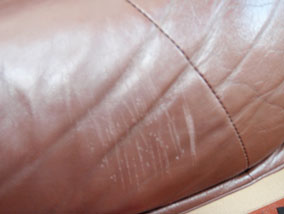
DAMAGE TYPES
This photo shows cat scratches on the seating cushion. You can see that the scratches are only very light and have not damaged the leather itself, only lightly scratching the coating away. For damage like this, the Leather Re-Colouring Balm should be sufficient to restore the colour that has been scratched away and blend the scratches in with the surrounding leather.
If the damage looks like the photo to the left; read the instructions below on how to fix it.
PRODUCTS REQUIRED
If the area of damage is larger than an area the size of a tennis ball:
- Leather Binder - To strengthen the area
- Heavy Filler - To fix the scratches
- Leather Colourant Kit - To restore the colour
Or if the area of damage is smaller than a tennis ball:
This type of cat damage is caused by the cat sticking it's claws into the leather. When the cat pulls it's claws out, it draws out the fibres of the leather. This causes significant damage and the leather becomes rough and unsightly.
STEP BY STEP GUIDE: REPAIRING CAT SCRATCHES ON A LEATHER SOFA
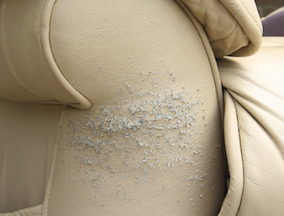
PREPARE AREA
As can be seen in the image to the left, this leather armchair has suffered significant damage from cat scratches to the left arm. Before attempting to repair cat scratches on leather, it is important to thoroughly clean the leather with Leather Ultra Clean to remove any dirt and grime. As this area of damage is larger than the area covered by a tennis ball, we will be using the Leather Colourant Kit rather than the Leather Repair Kit, but the same process can be used for both. If you are using the Leather Repair Kit, simply use a sponge in place of the Airbrush used in the later stages of the guide.
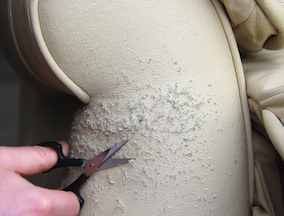
STEP 1: TRIM ANY LOOSE FIBRES
After cleaning the area, take a pair of sharp scissors and trim any loose fibres, often found with damage from cat scratches. Please note, that only the longer fibres need to be removed at this stage. Any shorter fibres that remain will not affect the quality of the repair or the look and feel of the end result. Take care at this stage not to puncture, cut or cause further damage to the leather.
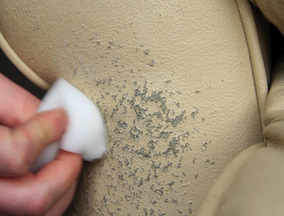
STEP 2: APPLY LEATHER BINDER
When you have trimmed the longer loose fibres, the next step is to apply the Leather Binder. To apply the Leather Binder, simply apply a small amount to a sponge and use this to rub directly into the area of damage. Coat the entire area and allow to dry. In order to ensure a strong, durable repair, apply 8-10 coats of Leather Binder, allowing sufficient time for the previous coat to dry before applying the next.

STEP 3: SAND THE AREA DOWN
Once the binder has been applied, the area should be sanded down in order to create a smooth, even surface on which to perform the remaining steps of the repair. To do this, simply take a piece of fine sandpaper (1200 grit is sufficient for this job) and lightly sand the entire area that the Leather Binder was applied to.

STEP 4: APPLY THE HEAVY FILLER
Before approaching this step, ensure that the area is free from any residue from sanding. Then, using the Heavy Filler and palette knife, spread a thin layer of filler over the scratches. Leave for 20-25 minutes to dry and apply additional layers if required, you should aim to have the holes, scratches and gouges filled so that they are level with the surface of the leather.

STEP 5: SAND AREA DOWN
After applying the filler, it should be sanded down, again, 1200 grit sandpaper is sufficient for this job. After sanding, wipe the leather down with the alcohol cleaner to remove any dirt and residue from the leather's surface. This ensures proper adhesion of colour when we come to apply it in later stages.
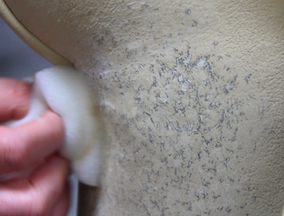
STEP 6: APPLY 1ST COAT OF COLOURANT
Once the Alcohol Cleaner has had time to dry, it is time for the colourant to be applied. Start off by applying the first coat of colour with a sponge. Simply pour a small amount onto a sponge and use this to apply a thin coat to the leather. Sometimes after applying the colourant, it emphasises some of the scratches you though were 'healed'. Simply apply more filler, sand down and re-apply the colourant as before.
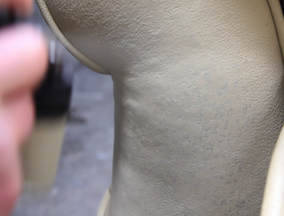
STEP 7: SPRAY ON COLOURANT
After the first coat of colourant has been applied, if using the Leather Colourant Kit; you should use the airbrush to begin building up the colourant in a series of thin layers, leaving time for the previous coat to dry before applying the next. If using the Leather Repair Kit, successive layers should be applied using the sponge. Apply as many thin layers as required to sufficiently blend with the surrounding area and conceal the repair.
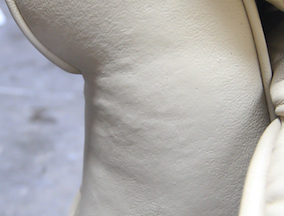
STEP 8: APPLY FINISH
Once you have a good coverage of colour, either by sponge or airbrush, the next step is to apply the lacquer onto the leather to seal the colour in. Take the glossy Super Seal and apply using a sponge or airbrush, in 3-4 layers. This forms the basis for a flexible and very robust finish. After this is done, apply the Leather Finish, using the contents provided in 4-5 layers. For both products, allow time for each coat to completely dry before applying the next.
By following these steps and using the products in this guide, you can achieve professional results when repairing cat scratches on all items of leather, with relatively little time, effort or cost.






